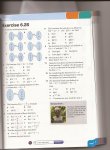Dr.Peterson
Elite Member
- Joined
- Nov 12, 2017
- Messages
- 16,084
I thought about that but then made the mistake of multiplying the whole thing by 1/3 when it should be (x+3)/2 * 1/3 ( I'm stepping on all the landmines today!) so doing that we're left with (x+3)/6 but comparing that to the original functions and inverses I'm not sure what to conclude.
You've got it.
Now let's check. We're claiming that this is g^-1(f^-1(x)), where f(x) = 2x+1 and g(x) = 3x-2, so that f^-1(x) = (x-1)/2and g^-1(x) = (x+2)/3.
Suppose that x = 9. Then f^-1(9) = 4, and g^-1(4) = 2. So g^-1(f^-1(x)) = 2.
What does your expression give? (x+3)/6 = (9+3)/6 = 2. So it agrees, at least for this input.
Also, the claim is that this is the inverse of the function f(g(x)). So if we put 2 into what you call fg, we should get that 9 back. Do we? Well, g(2) = 4, and f(4) = 9, so that works, too.
There are a lot of other things you might do, if you want to look at the problem from all angles. You might find what f(g(x)) is and work out its inverse, to see that you get the same result, for example.
This sort of "above and beyond" work is the way to milk an exercise of all its value, using it to gain lots of experience in doing the algebra, and also getting opportunities to observe how inverses and complements work out.

